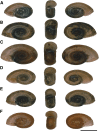Morphological and molecular characterization of invasive Biomphalaria straminea in southern China
- PMID: 30526682
- PMCID: PMC6286595
- DOI: 10.1186/s40249-018-0505-5
Morphological and molecular characterization of invasive Biomphalaria straminea in southern China
Abstract
Background: Schistosomiasis is a common parasitic disease designated as a neglected tropical disease by the World Health Organization. Schistosomiasis mansoni is a form of the disease that is caused by the digenean trematode Schistosoma mansoni, transmitted through Biomphalaria spp. as an intermediate host. Biomphalaria was introduced to Hong Kong, China in aquatic plants shipments coming from Brazil and the snail rapidly established its habitats in southern China. Earlier studies of Biomphalaria spp. introduced to southern China identified the snails as Biomphalaria straminea, one of the susceptible species implicated in S. mansoni transmission in South America. However, recent molecular investigations also indicated the presence of another South American species, B. kuhniana, which is refractory to infection. As such, it is important to identify accurately the species currently distributed in southern China, especially with emerging reports of active S. mansoni infections in Chinese workers returning from Africa.
Methods: We combined morphological and molecular taxonomy tools to precisely identify Biomphalaria spp. distributed in Guangdong Province, southern China. In order to clearly understand the molecular profile of the species, we constructed a phylogeny using mtDNA data (COI and 16S rRNA sequences) from six populations of Biomphalaria spp. from Shenzhen City in Guangdong Province. In addition, we examined the external morphology of the shell and internal anatomy of the reproductive organs.
Results: Both morphological and molecular evidences indicated a close affinity between Biomphalaria spp. populations from Guangdong and B. straminea from Brazil. The shell morphology was roughly identical in all the populations collected with rounded whorls on one side and subangulated on the other, a smooth periphery, an egg-shaped aperture bowed to one side, and a deep umbilicus. The shape and number of prostate diverticula (ranged from 11.67 to 17.67) in Guangdong populations supports its close affinity to B. straminea rather than B. kuhniana. Molecular analysis did not conflict with morphological analysis. Little genetic differentiation was observed within Biomphalaria populations collected. Phylogenetic analysis of COI and 16S rRNA haplotypes from snails collected and B. straminea sequences from Brazil and China using Bayesian inference revealed that Guangdong populations were clustered in one clade with B. straminea from Hong Kong of China and B. straminea from Brazil indicating their close affinity to each other.
Conclusions: Data obtained in the current study clearly show that the populations of Biomphalaria spp. investigated are B. straminea, and we assume that those snails were either introduced via passive dispersal from Hong Kong of China or as a result of multiple introduction routes from Brazil.
Keywords: Biomphalaria straminea; Intestinal schistosomiasis; Invasive species; Molecular taxonomy; Schistosoma mansoni; Susceptibility.
Conflict of interest statement
Ethics approval and consent to participate
Ethical clearance of this pilot had been granted approval by the Ethics Committee of the National Institute of Parasitic Diseases, Chinese Center for Disease Control and Prevention in Shanghai, China (permit number 20160627).
Consent for publication
Not applicable
Competing interests
Dr. Xiao-Nong Zhou is the Editor-in-Chief of
Figures







References
-
- WHO . Schistosomiasis. Fact Sheet number 115. Geneva: WHO; 2011.
-
- Diakite NR, Winkler MS, Coulibaly JT, Guindo-Coulibaly N, Utzinger J, N'Goran EK. Dynamics of freshwater snails and Schistosoma infection prevalence in schoolchildren during the construction and operation of a multipurpose dam in central cote d'Ivoire. Infect Dis Poverty. 2017;6:93. doi: 10.1186/s40249-017-0305-3. - DOI - PMC - PubMed
-
- Brown D. Freshwater snails of Africa and their medical importance. 2. London: Taylor and Francis; 1994.
MeSH terms
Substances
Grants and funding
LinkOut - more resources
Full Text Sources
Research Materials
Miscellaneous

